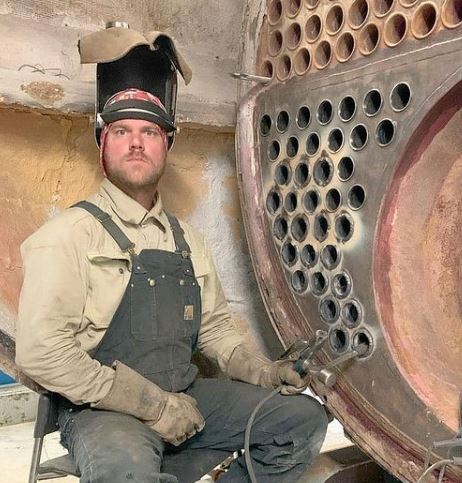The TIG welding process uses tungsten electrodes to create welds and is also known as Gas Tungsten Arc Welding (GTAW). TIG welding is a manual process, which means that the welder must use their hand to control the torch and the filler metal and manually initiate the arc.
One of the main differences between TIG welding and other welding methods is using a non-consumable electrode. Welds made with TIG welding do not melt the electrode but become part of it. Instead, the heat generated by the arc melts the metal being welded and the filler metal, which is then joined together to form the weld.
Another difference between TIG welding and other welding methods is how the arc is initiated. TIG welding starts the angle by touching the tungsten electrode to the metal being welded and then separating it slightly. This is known as “scratching the start.” In other welding methods, such as MIG welding, the arc is started by a continuous wire feeding through the torch and into the weld puddle.
Overall, TIG welding is known for its precision and control and is often used to weld thin materials or materials that require a high level of aesthetic quality. It is also a clean welding process, producing visually appealing welds free of spatter and slag.

Advantages of TIG welding
There are several advantages to using TIG welding over other welding methods:
- Precision and control: TIG welding allows the welder to have precise control over the weld, making it suitable for delicate or intricate welding projects. The welder can control the heat input, the speed of the weld, and the amount of filler metal used, allowing for precise and accurate welds.
- Ability to weld thin materials: TIG welding is well-suited for welding thin materials, such as sheet metal or tubing, as it allows the welder to control the heat input and avoid overheating and warping the material.
- Clean, visually appealing welds: TIG welding produces clean welds free of spatter and slag. This makes it suitable for projects where aesthetics are important, such as in the aerospace and aviation industries or in creating art and sculpture.
- Versatility: TIG welding can weld many materials, including stainless steel, aluminum, copper, and nickel, making it a versatile welding method.
- Safety: TIG welding produces less smoke and fumes than other welding methods, making it a safer choice for welders and those working in the vicinity of the weld.
TIG welding is a precise and versatile method suitable for various projects and industries. Its ability to produce clean, visually appealing welds and its safety advantages make it a popular choice among welders.
Common Applications of TIG welding
TIG welding has a wide range of applications in various industries, including:
- Aerospace and aviation: TIG welding is often used in the aerospace and aviation industries due to its precision and ability to produce clean, visually appealing welds. It welds aircraft components such as fuselages, wing panels, and landing gear.
- Automotive and motorcycle repair: TIG welding is often used in the automotive and motorcycle industries for repair work and custom fabrication. It is suitable for welding thin materials, such as sheet metal, and is used to repair or modify car and motorcycle bodies and weld custom exhaust systems.
- Construction and fabrication: TIG welding is used in the construction industry for welding structural steel components, such as beams and columns. It is also used to fabricate metal products, such as handrails, fencing, and gates.
- Art and sculpture creation: TIG welding is often used by artists and sculptors to create metal sculptures and other works of art. Its precision and ability to produce clean, visually appealing welds make it a popular choice for artistic projects.
Overall, TIG welding is a versatile method with various applications in various industries. Its precision and ability to produce clean, visually appealing welds make it suitable for projects requiring high quality and attention to detail.
Materials Suitable for TIG welding
TIG welding can be used to weld a wide range of materials, including:
- Stainless steel: TIG welding is a popular choice for welding stainless steel due to its precision and ability to produce clean, visually appealing welds. It is often used to weld thin sheets of stainless steel and thicker sections and is suitable for ferritic and austenitic stainless steel alloys.
- Aluminum: TIG welding is well-suited for welding aluminum and its alloys, as it allows the welder to control the heat input and avoid overheating and warping the material. It is often used to weld thin sheets of aluminum, as well as thicker sections, and is suitable for both pure aluminum and aluminum alloys.
- Copper and its alloys: TIG welding can be used to weld copper and its alloys, such as bronze and brass. It is a precise welding method that is well-suited for welding thin materials and is often used to weld copper pipes and tubes.
- Nickel and its alloys: TIG welding can be used to weld nickel and its alloys, such as Inconel and Hastelloy. It is a precise welding method that is well-suited for welding thin materials and is often used to weld nickel pipes and tubes.
Overall, TIG welding is a versatile method used to weld many materials, including stainless steel, aluminum, copper, and nickel. Its precision and ability to produce clean, visually appealing welds make it suitable for various welding projects.
Conclusion
In conclusion, TIG welding is a versatile and precise welding method with various applications in various industries. Its ability to produce clean, visually appealing welds and precision and control make it suitable for various projects, including those requiring a high level of aesthetic quality. TIG welding can be used to weld many materials, including stainless steel, aluminum, copper, and nickel. It is known for its ability to weld thin materials without overheating or warping them. Overall, TIG welding is a popular choice among welders due to its versatility, precision, and ability to produce high-quality welds.

It’s been years since I got into welding as a side hustle. It’s been so long since Doing All kinds of welds for business and pleasure as this is my hobby. Being in this field I have learned from hands-on-experience also came to know what gears work and what doesn’t. The Tig Welder is my own platform where I use to share my experience.






Leave a Reply